Ford Capri
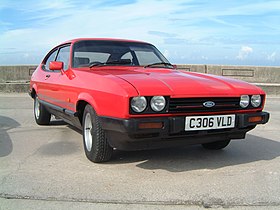
1986 Ford Capri Mk III Laser |
| Manufacturer | Ford Motor Company |
|---|
| Production | 1961–64
1969–86
1989–94 |
|---|
| Class | Mid-size coupé (1969–86)
Roadster (1989–94) |
|---|
| Related | Ford Cortina |
|---|
Ford Capri was a name used by the Ford Motor Company for three different automobile models. The Ford Consul Capri coupé was produced by Ford of Britain between 1961 and 1964. The Ford Capri coupé was produced by Ford of Europe from 1969 to 1986. The Ford/Mercury Capri convertible was produced by the Ford Motor Company of Australia from 1989 to 1994.
The Capri name was also used by Ford's Lincoln-Mercury Division on six different models which did not bear the Ford name. The Lincoln Cosmopolitan Capri from 1950 to 1951; the Lincoln Capri from 1952 to 1959; the Mercury Comet Capri in 1966–1967; and three different generations of Mercury Capris from 1970 to 1994.
History
Ford Consul Capri (335) (1961–64)
Ford Consul Capri
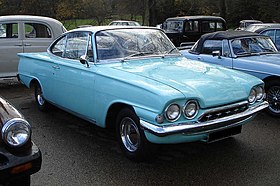
1962 Ford Consul Capri |
| Manufacturer | Ford of Britain |
|---|
| Body style | 2-door coupé |
|---|
| Engine | 1340 cc I4 (OHV)
1961–1962
1498 cc I4 OHV
1962–1964 |
|---|
| Wheelbase | 99 in (2,515 mm) |
|---|
| Length | 170.75 in (4,337 mm) |
|---|
| Width | 65.3 in (1,659 mm) |
|---|
| Height | 54 in (1,372 mm) |
|---|
| Curb weight | 2,100 lb (953 kg) approx |
|---|
| Related | Ford Consul Classic |
|---|
The Capri was a two-door coupé version of the Ford Classic saloon made by Ford of Britain. The Ford Classic was a result of 4 years of development. Approval for the project was given in autumn 1956. The styling of the car was the last project undertaken by Colin Neale before he left Dagenham for Dearborn. The initial design requirement was for the Ford Classic to be a full range model to take Ford into the new decade. Ford even developed a full-size estate (station wagon) prototype.
The Capri Project was code named "Sunbird" and took design elements from the Ford Thunderbird and the Ford Galaxie Sunliner. It was instigated by Sir Horace Denne, Ford's Sales Director. He wanted a "co-respondent's" car to add glamour to the product line. It was designed by Charles Thompson who worked under Neale and had sweeping lines, a large boot space and a pillarless coupé roof.
On its September announcement the Consul Capri was for export only but went on sale to the domestic British market in January 1962. The bodies were sub-assembled by Pressed Steel Company, with only final assembly of the drivetrain taking place at Dagenham and from February 1963 at Halewood. It was intended as part of the Ford Classic range of cars but the body was complex and expensive to produce. With new production methods, time demands from Dearborn and a need to match opposition manufacturers in price, the Ford Classic and Consul Capri were almost doomed from the start. The Ford Classic was made from 1961 to 1963, and replaced by the Cortina-derived Ford Corsair.
The Consul Capri included Ford Classic De-Luxe features, including four headlights, variable speed wipers, 9.5 in (241 mm) front disc brakes, dimming dashboard lights, and a cigar lighter. The four-speed transmission was available with either a column or floor change. It was proclaimed as "The First Personal car from Ford of Great Britain" (Ford of Great Britain, sales literature, December 1961)
Initially fitted with a 1340 cc 3 main bearing engine (model 109E), the early cars were considered underpowered and suffered from premature crankshaft failure. Engine capacity was increased in August 1962 to 1498 cc (model 116E) and this engine with its new 5 bearing crankshaft was a vast improvement. The first 200 Capris were left-hand-drive cars for export including Europe and North America. In Germany at the 1961 Frankfurt Auto Show, Ford sold 88 Capris.
In February 1963 a GT version (also 116E) was announced. The new GT engine, developed by Cosworth, featured a raised compression ratio to 9:1, a modified head with larger exhaust valves, an aluminium inlet manifold, a four branch exhaust manifold and, most noticeably, a twin-choke Weber carburettor – this being the first use of this make on a British production car. The same engine was announced for use in the Ford Cortina in April 1963.
Overall the car was very expensive to produce and in the latter part of its production was running alongside the very popular Ford Cortina. Sales were disappointing and the Consul Capri was removed from sale after two and a half years with 19,421 sold, of which 2002 were GT models. 1007 cars were sold in 1964, the last year of production, 412 of them being GTs. The Consul Capri was discontinued in July 1964. The Consul Capri (335) is one of the rarest cars from Ford of Great Britain.
A Capri was tested by the British The Motor magazine in 1962 and had a top speed of 79.0 mph (127.1 km/h) and could accelerate from 0-60 mph (97 km/h) in 22.6 seconds. A fuel consumption of 36.7 miles per imperial gallon (7.70 L/100 km; 30.6 mpg-US) was recorded. The test car cost £915 including taxes of £288.
Ford Capri Mk I (1969–1974)
Ford Capri Mk I

1974 Ford Capri 3.0 GXL |
| Manufacturer | Ford of Europe |
|---|
| Also called | Mercury Capri |
|---|
| Production | 1969–1974 |
|---|
| Assembly | Dagenham, Halewood, United Kingdom
Genk, Belgium
Cologne, Saarlouis, Germany
Homebush, Australia |
|---|
| Successor | Ford Capri Mk II |
|---|
| Class | Mid-size sports car |
|---|
| Body style | Fastback coupé |
|---|
| Layout | FR layout |
|---|
| Engine | petrol:
V4 1.3 L, 1.5 L, 1.7 L, 2.0 L (UK)
I-4 1.3 L, 1.6 L, 2.0 L,
V6 2.0 L, 2.6 L, 3.0 L, 3.1vL, 3.4 L |
|---|
| Transmission | 4-speed manual all-synchromesh |
|---|
| Wheelbase | 100.8 in (2,560 mm) |
|---|
| Length | 168.5 in (4,280 mm) |
|---|
| Width | 64.8 in (1,646 mm) |
|---|
| Height | 50.7 in (1,288 mm) |
|---|
| Curb weight |
2,053 lb (931 kg)
2,522 lb (1,144 kg) 3000GXL |
|---|
The first Ford Capri to bear that precise name was introduced in January 1969 at the Brussels Motor Show, with sales starting the following month. The intention was to reproduce in Europe the success Ford had had with the North American Ford Mustang; to produce a European pony car. It was mechanically based on the Cortina and built in Europe at the Dagenham and Halewood plants in the United Kingdom, the Genk plant in Belgium, and the Saarlouis and Cologne plants in Germany. The car was named Colt during development stage, but Ford was unable to use the name, as it was trademarked by Mitsubishi.
Although a fastback coupé, Ford wanted the Capri Mk I to be affordable for a broad spectrum of potential buyers. To help achieve that, it was available with a variety of engines. The British and German factories produced different line-ups. The continental model used the Ford Taunus V4 engine in 1.3, 1.5 and 1.7 L engine displacement, while the British versions were powered by the Ford Kent straight-4 in 1.3 and 1.6 L form. The Ford Essex V4 engine 2.0 L (British built) & Cologne V6 2.0 L (German built) served as initial range-toppers. At the end of the year, new sports versions were added: the 2300 GT in Germany, using a double-barrel carburettor with 125 PS (92 kW), and in September 1969 the 3000 GT in the UK, with the Essex V6, capable of 138 hp (103 kW).
Under the new body, the running gear would have been familiar to anyone used to working on the underside of a 1966 Cortina. Rear suspension employed a live axle supported on leaf springs with short radius rods.MacPherson struts featured at the front in combination with rack and pinion steering which employed a steering column that would collapse in response to a collision.
The initial reception of the car was broadly favourable. In the June 1970 edition of the Monthly Driver's Gazette, tester Archie Vicar wrote of the gearchange that it was "...in Ford fashion easy to operate but not very jolly". In the same review Vicar summed up the car as follows: "Perhaps with a bit of work it can be given road-holding and performance less like an American car and more like a European one".
The range continued to be broadened, with another 3.0 variant, the Capri 3000E introduced from the British plant in March 1970, offering "more luxurious interior trim".
In April 1970, Ford began selling the Capri outside Europe, in the North American, South African and Australian markets. These versions all used the underpowered Kent 1.6 engine although a Pinto straight-4 2.0 L replaced it in 1971. An exception though, was the Perana manufactured by Basil Green Motors near Johannesburg, which was powered by a 302ci V-8 Ford Windsor engine. All North American versions featured the "power dome" hood and four round 5¾" US-spec headlights. They carried no "Ford" badging, as the Capri was sold by only Mercury dealers and promoted to US drivers as "the sexy European".
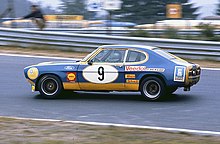
Hans Heyer 1973 with Ford Capri at the Nürburgring
A new 2637 cc version of the Cologne V6 engine assembled by Weslake and featuring their special all alloy cylinder heads appeared in September 1971, powering the Capri RS2600. This model used Kugelfischer fuel injection to raise power to 150 PS (110 kW) and was the basis for the Group 2 RS2600 used in the European Touring Car Championship. The RS2600 also received modified suspension, a close ratio gearbox, lightened bodywork panels, ventilated disc brakes and aluminium wheels. It could hit 100kph from a standstill in 7.7 seconds. The 2.6 L engine was detuned in September for the deluxe version 2600 GT, with 2550 cc and a double-barrel Solex carburettor. Germany's Dieter Glemser won the Drivers' title in the 1971 European Touring Car Championship at the wheel of a Ford Köln entered RS2600 and fellow German Jochen Mass did likewise in 1972.
The first Ford Special, was the Capri Vista Orange Special. The Capri Special was launched in November 1971 and was based on the 1600 GT, and 2000 GT models. It was only available in Vista orange and was optional dealer fitted with a Ford Rally Sport (RS) boot mounted spoiler and rear window slats – a direct link to the Mustang. The Special also had some additional standard extras such as a push-button radio, fabric seat upholstery, inertia reel seat belts, heated rear screen and black vinyl roof.There were only 1200 Vista Orange Capri specials made. One of the last limited editions of the original Mk I, was a version that came in either Metallic Green or black with Red interior and featured some additional extras, such as cloth inserts in the seats, hazard lights, map reading light, opening rear windows, vinyl roof and for the first time a bonnet bulge was fitted to the sub-3.0-litre models. This special edition was only available with a 1.6 or 2.0 engines and had the full title of GTXLR Special.
Mk I facelift
The Capri proved highly successful, with 400,000 cars sold until 1970. Ford revised it in 1972 to become what is known by enthusiasts as the Capri "Bis" (i.e. "second") or, in the UK, the "Mk I facelift" Capri.The car received a new and more comfortable suspension, rectangular headlights, enlarged tail-lights and new seats. The Kent engines were replaced by the Ford Pinto engine and the previously UK-only 3000 GT joined the German line-up. In the UK the 2.0 L V4 remained in use.
In addition, North American versions received larger rubber-covered bumpers (to comply with US DOT regulations) for 1973.
1973, saw the highest sales total the Capri ever attained, at 233,000 vehicles: the 1,000,000th Capri, an RS 2600, was completed on 29 August.
In December, Ford replaced the Cologne V6 based RS2600 with the Essex V6 based RS3100, with the usual 3.0 L Essex V6's displacement increased to 3098 cc. Unlike its predecessor, it used a double-barrel Weber carburettor, and reached the same 150 PS (110 kW). Only 250 RS3100s were built for homologation purposes. However, the car was still competitive in touring car racing, and Ford Motorsport produced a 100-model limited edition with this new engine. The Group 4 RS3100's engine was tuned by Cosworth into the GAA, with 3412 cc, fuel injection, DOHC, four valves per cylinder and 435 hp (324 kW) in racing trim. The car also featured improved aerodynamics. Besides the racing RS3100, the GAA was also used in Formula 5000.
Ford Capri Mk II – 'Capri II' (1974–1978)
Ford Capri Mk II

1974 Ford Capri Mk II |
| Manufacturer | Ford of Europe |
|---|
| Also called | Mercury Capri |
|---|
| Production | 1974–1978 |
|---|
| Assembly | Dagenham, Halewood, United Kingdom
Genk, Belgium
Saarlouis, Cologne, Germany |
|---|
| Predecessor | Ford Capri Mk I |
|---|
| Successor | Ford Capri Mk III |
|---|
| Class | Mid-size sports car |
|---|
| Body style | Hatchback coupé |
|---|
| Layout | FR layout |
|---|
| Engine | petrol:
I-4 1.3 L 1.6 L, 2.0 L,
V6 2.3 L, 3.0 L |
|---|
| Transmission | Manual transmission |
|---|
In February 1974, the Capri II was introduced. After 1.2 million cars sold, and with the 1973 oil crisis, Ford chose to make the new car more suited to everyday driving with a shorter bonnet, larger cabin and the adoption of a hatchback rear door. By the standards of the day, the Capri II was a very well evolved vehicle with very few reliability issues. For Germany the Capri now offered 1.3-litre (55 PS (40 kW)), 1.6-litre (72 PS (53 kW)), 1.6-litre GT (88 PS (65 kW)), or 2.0-litre (99 PS (73 kW)) in-line four-cylinder engines, complemented by a 2.3-litre (108 PS (79 kW)) and the UK sourced 3.0-litre V6.
Although it was mechanically similar to the Mk I, the Capri II had a revised larger body and a more modern dashboard including a smaller steering wheel. The 2.0 L version of the Pinto engine was introduced in the European model and was placed below the 3.0L V6. The Capri still maintained the large square headlights, which became the easiest way to distinguish between a Mk II and a Mk III. Larger front disc brakes and a standard alternator finished the list of modifications.

1975 Ford Capri Mk II 2.0 JPS
Ford introduced the John Player Special limited edition, (known as the JPS) in March 1975. Available only in black or white, the JPS featured yards of gold pinstriping to mimic the Formula 1 livery, gold-coloured wheels, and a bespoke upgraded interior of beige cloth and carpet trimmed with black. In May 1976, and with sales decreasing, the intermediate 3.0 GT models disappeared to give way for the upscale 3.0 S and Ghia designations. In October 1976, production was limited to the Saarlouis factory only and the following year the Capri left the American market with only 513,500 models sold.
Ford Capri Mk III (1978–1986)
Ford Capri Mk III

Ford Capri III S |
| Manufacturer | Ford of Europe |
|---|
| Production | 1978–1986 |
|---|
| Assembly | Dagenham, Halewood, United Kingdom
Genk, Belgium
Cologne, Saarlouis, Germany |
|---|
| Predecessor | Ford Capri Mk II |
|---|
| Class | Mid-size sports car |
|---|
| Body style | Hatchback coupé |
|---|
| Layout | FR layout |
|---|
| Engine | petrol:
I-4 1.3 L, 1.6 L, 2.0 L,
V6 2.0 L, 2.3 L, 2.8 L, 3.0 L |
|---|
| Transmission | Manual transmission,
Automatic transmission |
|---|
| Wheelbase | 101 in (2,565 mm) |
|---|
| Length | 167.8 in (4,262 mm) |
|---|
| Width | 67 in (1,702 mm) |
|---|
| Height | 51 in (1,295 mm) |
|---|
| Curb weight | 2,227 lb (1,010 kg) 1.3L
2,293 lb (1,040 kg) 1.6S
2,273 lb (1,031 kg) 2.0S
2,620 lb (1,188 kg) 2.8i
2,688 lb (1,219 kg) 3.0S |
|---|
The Capri Mk III was referred to internally as "Project Carla", and although little more than a substantial update of the Capri II, it was often referred to as the Mk III. The first cars were available in March 1978, but failed to halt a terminal decline in sales. The concept of a heavily facelifted Capri II was shown at the 1976 Geneva show: a Capri II with a front very similar to the Escort RS2000 (with four headlamps and black slatted grille), and with a rear spoiler, essentially previewed the model some time before launch. The Mk III featured improved aerodynamics, leading to improved performance and economy over the Mk II and the trademark quad headlamps were introduced.
At launch the existing engine and transmission combinations of the Capri II were carried over, with the 3.0 S model regarded as the most desirable model although the softer Ghia derivative with automatic, rather than manual transmission, was the bigger seller of the two V6-engined models.
Mk III models available:
- Capri L (1.3, 1.6)
- Capri LS (1.6)
- Capri GL (1.6, 2.0)
- Capri S (1.6, 2.0, 2.3, 3.0)
- Capri Laser (1.6, 2.0)
- Capri Ghia (2.0, 3.0)
- Capri 2.8 Injection (2.8)
- Capri 2.8 Injection Special (2.8)
- Capri 280 (2.8)
Special limited addition trimmed models:
- Capri Cabaret I and II (1.6, 2.0)
- Capri Calypso I and II (1.6)
- Capri Cameo (1.3, 1.6)
- Capri GT4 (1.6, 2.0)
- Capri Tempo (1.3, 1.6)
Ford began to focus their attention on the UK Capri market as sales declined, realising the car had something of a cult following there. Unlike sales of the contemporary 4-door Cortina, Capri sales in Britain were to private buyers who would demand less discounts than fleet buyers allowing higher margins with the coupé. Ford tried to maintain interest in 1979 with Ford Rallye Sport, Series X, "X Pack" options from the performance oriented RS parts range. Although expensive and slow selling these proved that the press would enthusiastically cover more developed Capris with higher performance.
Despite being the most popular sporting model in Britain for most of its production life, the third generation Capri was also one of the most stolen cars in Britain during the 1980s and early 1990s, being classified as "high risk" of theft in a Home Office report.
The 3.0 S was used extensively in the TV series The Professionals, with characters Bodie driving a silver 3.0 S and Doyle a gold 3.0 S, which was credited with maintaining interest in the car in the UK.
2.8 Injection models
In 1981, the 3.0 V6 powerplant was dropped from the line-up, while a new sporty version debuted at the Geneva Motor Show, called the 2.8 Injection. The new model was the first regular model since the RS2600 to use fuel injection. Power rose to 160 PS (118 kW) giving a top speed of 210 km/h (130 mph), but the car still had a standard four-speed gearbox. The Capri 2.8 Injection breathed new life into the range and kept the car in production 2–3 years longer than Ford had planned. The four-speed gearbox was replaced with a five-speed unit early on – at the same time Ford swapped the dated looking chequered seats for more luxurious looking velour trim. A more substantial upgrade was introduced in 1984 with the Capri Injection Special. This development used half leather seating and included a limited slip differential. Externally the car could be easily distinguished by seven spoke RS wheels (without the customary "RS" logo since this was not an RS vehicle) and color-coded grille and headlamp surrounds. At the same time the 2.0 Capri was rationalised to one model the 2.0 S, which simultaneously adopted a mildly modified suspension from the Capri Injection. The 1.6 model was also reduced to one model, the 1.6 LS.
2.8 Turbo
From July 1981 to Sept 1982, German RS dealers marketed a limited edition, Zakspeed inspired, left-hand drive only, 'Werksturbo' model with 190 PS (140 kW), which could propel the car to 220 km/h (137 mph). Based on a 3.0 S, this derivative featured widened bodywork, front and rear 'Ford Motorsport' badged spoilers, deep 7.5j four-spoked RS alloy wheels and an RS badged engine. The engine was based on a normally aspirated 2.8-litre V6, Ford Granada (Europe) engine. Figures of around 200 produced examples are common, but numbered transmission tunnels possibly indicate 155 conversions were made.
Tickford Turbo
The Tickford Capri used a turbocharged 2.8 Injection Cologne engine which developed 205 hp (153 kW), allowing it to reach 60 miles per hour in 6.7 seconds and 100 miles per hour in 13.4 seconds, topping out at 137 miles per hour. This version also featured a luxury interior with optional full leather retrim and Wilton carpeting and headlining,large rear spoiler, colour-coded front grille, deeper bumpers and 'one off' bodykit designed by Simon Saunders, later of KAT Designs and now designer of the Ariel Atom.
Rear disc brakes were standard on the Tickford, which featured numerous other suspension modifications. This model was essentially rebuilt by hand by Tickford at approximately 200 hours per car. It sold fewer than 100 units. One problem was the relative price difference to the standard Capri Injection, with the Tickford version costing twice as much.
Turbo Technics conversions
Independent tuner Turbo Technics also released a turbocharged 200 hp (149 kW) and 230 hp (172 kW) evolution which came supplied with a specially built gearbox. The Tickford Capri pricing issues meant that Ford also sanctioned the Turbo Technics conversion as semi-official, although only the German RS and British Tickford ever appeared in Ford literature as official Ford products.
Capri Laser
From November 1984 onwards, the Capri was sold only in Britain, with only right hand drive cars being made from this date. The normally aspirated 1.6 and 2.0 variants were rebranded with a new trim level – "Laser" – which featured a fully populated instrument pod, leather gear lever, leather steering wheel, four-spoke alloy wheels as used on the S models, an electric aerial and colour-coded grille and mirrors.
Capri 280

1987 Ford Capri Mk III 280
The last run limited edition "Brooklands" Green, 280 model, featuring a limited slip differential, full leather Recaro interior and 15 inch versions of the seven spoke 13 inch wheels fitted to the superseded Capri Injection Special. Ford originally intended to make 500 turbo charged vehicles (by Turbo Technics) complete with gold alloy wheels and name it the Capri 500 but a change of production planning meant a name change to Capri 280 as the cars were simply the last models that ran down the production line. A total of 1,038 Capri 280s were built.
When the last Capri was made on 19 December 1986, 1,886,647 cars had rolled off the production lines. Production had ended at Halewood, UK in 1976 and the Capri was made exclusively in Germany from 1976 to 1986. Most of those (more than a million) were the Mk I, because the Mk I sold well in North America and Australia, while the Mk II and Mk III were only exported outside Europe (to Asia and New Zealand) in limited numbers.
Mk III Specifications
Ford Capri Mk III Technical Specifications 1978–1986
| Ford Capri: | 1.3 | 1.6 LC | 1.6 HC | 2.0 | 2.0 (V6) | 2.3 | 2.8i | 2.8 Turbo | 3.0 |
|---|
| Engine: | 4-cylinder inline engine | 6-cylinder V-engine |
| Capacity: | 1297 cc | 1593 cc | 1993 cc | 1999 cc | 2294 cc | 2792 cc | 2994 cc |
| Bore × stroke: | 80.98 × 62.99 | 87.7 × 66 mm | 90.8 × 77 mm | 84.6 × 60,1 mm | 90 × 60.14 mm | 93 × 68.85 mm | 93.67 × 72.42 mm |
Performance
at peak RPM: | 51.5 kW
(70)
5500 | 51 kW
(70 PS)
5300 | 54 kW
(73 PS)
5300 | 74 kW
(101 PS)
5200 | 66 kW
(90 PS)
5100 | 84 kW
(114 PS)
5300 | 118 kW
(160 PS)
5700 | 138 kW
(188 PS)
5500 | 101 kW
(138)
5000 |
Max. Torque
at peak RPM: | 92.2 Nm
4000 | 113 Nm
2700 | 117 Nm
2700 | 153 Nm
4000 | 141 Nm
3000 | 176 Nm
3000 | 221 Nm
4300 | 263 Nm
4500 | 235 Nm
3000 |
| Compression ratio: | 9.2:1 | 8.2 : 1 | 9.2 : 1 | 9.2 : 1 | 8.2 : 1 | 9.0 : 1 | 9.2 : 1 | 9.2 : 1 | 9.0:1 |
| Fuel system: | 1 Downdraft carburettor | 1 Twin-choke downdraft carburettor | Fuel injection (Bosch K-Jetronic) | 1 Garrett turbo charger | 1 Twin-choke downdraft carburettor |
| Valve control: | (OHV) | overhead camshaft (OHC), timing belt | central camshaft (OHV), bumpers and rockers, timing wheels |
| Cooling: | Water-cooled |
| Transmission: | 4-speed manual transmission
(later 5-speed manual or 3-speed automatic (Ford C3)) |
| Front suspension: | MacPherson-Struts, coil springs |
| Rear suspension: | Rigid axle with semi-elliptic leaf springs |
| Chassis: | Steel, monocoque chassis |
| Track width front/rear: | 1353–1400/1384–1431 mm |
| Wheelbase: | 2563 mm |
| Length: | 4376–4439 mm |
| Unladen weight: | 1010 kg | 1060 kg | 1031–1250 kg |
| Top speed: | 157 km/h (98 mph) | 157 km/h (98 mph) | 160 km/h (99 mph) | 180 km/h (112 mph) | 170 km/h (106 mph) | 183 km/h (114 mph) | 210 km/h (130 mph) | 220 km/h (137 mph) | 196.3 km/h (122 mph) |
Acceleration
0–100 km/h: | 16.3 s | 16.3 s | 13.8–19 s | 11.1–14.5 s | 13–15.5 s | 10.5–13 s | 8.1–8.5 s | 8 s | 8.8 s |
Fuel consumption
Liter/100 Kilometer: | 9.0 | 11.5 | 11.5–12.5 | 13–14 | 13.5–14.5 | 13.5–14.5 | 15 | 15.5 | |
Outside Europe
North America
Mercury Capri
From 1970 to 1978, the Capri was sold in North America through Ford's Lincoln-Mercury Division. All were German-produced. Headlamps were four round sealed-beams, and turn signal lamps were grill-mounted on all US-spec 1971–74 Capris and 1976–78 Capri IIs. Ford hood letters were replaced with Capri letters, and a trunk-mounted Mercury script was added.Full instrumentation wasn't available on 1971–72 four-cylinder models but was made standard equipment from 1973 on. An optional interior decor package, changed by name to the "Ghia" package for the Capri II, featured deluxe interior trim and features. 1973 Ford Capris were the Mk I face-lift models featuring the new grill, larger taillights and new interior and dash. The 1973 model had the federally mandated 5 mph front bumper for '73. The bumper was extended, the gap closed with a silver filler panel. 1974 models had larger bumpers front and rear with wraparound urethane, body-color bumper covers to meet the revised Federal front and rear 5 mph standard. 1976–78 models were the re-designed hatchback models offered worldwide since 1974, fitted with the grill-mounted turn signal lamps and the required round sealed-beam headlamps, 5 mph body-color bumpers and catalytic converter, requiring no-lead fuel. In 1976, an 'S' (JPS) special edition featured black or white paint with gold-coloured wheels, gold pin-striping, and upgraded two-tone interior in beige and black. Due to late production of Capri IIs, there were no 1975 models sold in the USA.

1974 Capri 2800, with bigger safety bumpers
Originally, Cologne-built Capris imported to North America were fitted only with the British 1600 OHV (1.6 L), 64 hp (48 kW) Kent engine with the four-speed manual transmission. The 1971 Capri offered the Kent-built 1600 I4 and the optional, Cologne-built OHC 2000 (2.0 L) I4 engine for improved performance with 101 hp (75 kW). An optional three-speed automatic transmission was made available with the 2000 I4 engine. In 1972–73, the 2000 I4 became the standard engine, and an OHV 2600 (2.6 L) Cologne V6 was optional, which produced 120 hp (89 kW). The 1600 I4 was dropped. For 1974, new engines were used—the OHC 2300 (2.3 L) I4 and OHV 2800 (2.8 L) Cologne V6; producing 88 hp (66 kW) and 105 hp (78 kW) respectively.The engines were carried over for the 1976–77 Capri ll hatchback models, although the V6's power had crept up to 109 hp (81 kW) at 4,800 rpm.The last Capris were brought in 1977 although sales of leftovers continued into 1978. Capri sales had slid considerably by the time of the introduction of the Capri II, and the high price contributed to ending sales of German-built Capris in the US.
In 1979, no longer importing the Ford Capri, but capitalising on the model's positive image, Mercury dealers began selling a new Capri that was a re-styled Ford Mustang. It was initially available with an 88 hp (66 kW), 2.3 L 4, 2.8 L V6 and 302 (5.0 L) V8. The 2.8 L V6 was phased out very early in the 1980 model year and the 3.3 L (200 cu in) I6 replaced it. The 3.3 L I6 would be phased out in 1983 for a 3.8 L V6 with a carburetor and then CFI fuel injection in 1984. In 1984, the Capri was available with a 175 hp (130 kW) turbocharged 2.3 L four-cylinder engine or a 175 hp (130 kW) 302 V8. While lighter than the V8 model, the Capri Turbo lacked the torque of the V8 and suffered from turbo lag, making it slower. Next year, the V8 was rated at 210 hp (157 kW) and the turbo model was dropped. After 1986, the US-built Mercury Capri was dropped.
In 1991, a new Mercury Capri was introduced, this model being fully imported from Australia (see below). It was a convertible with four seats, front-wheel drive and a 100 hp (75 kW) four-cylinder 1.6 L engine. It was also available with a 132 hp (98 kW) 1.6 turbo engine. Both versions were dropped after 1994.
Australia
Mk I
The Ford Motor Company of Australia manufactured the European-designed Mk I Capri at its plant in the Sydney suburb of Homebush from 1969 until 1972. The Capri was offered to the Australian market from 3 May 1969, as the 1600 Deluxe and the 1600 GT, using the 1.6 L Ford Kent OHV engine. On 25 February 1970, the 3000 GT was launched, equipped with the 3.0 L Ford Essex V6. At the same time the 1600 GT became the 1600 XL while the 1600 Deluxe remained unchanged.
In November 1972, production of the Capri ended in Australia, with a total of 15,122 vehicles having been made. In 1973, Ford Australia imported fifty Capri RS3100 models. Neither the Mk I facelift Capri nor the subsequent Mk II and Mk III models were ever produced in Australia.
SA30
| Model | Released | Turbo version |
|---|
| SA Capri 2D Convertible | October 1989 | Yes |
| SA Series II Capri 2D Convertible | October 1990 | Yes |
| SC Capri XR2 2D Convertible | April 1992 | Yes |
| SC Capri Clubsprint 2D Convertible | July 1992 | Yes |
| SC Capri Barchetta 2D Convertible | November 1992 | No |
| SE Capri Barchetta 2D Convertible | August 1993 | No |
| SE Capri XR2 2D Convertible | August 1993 | Yes |
| SE Capri Clubsprint 2D Convertible | August 1993 | Yes |

1989–1992 Ford Capri (SA) convertible, with optional removable hardtop roof
The Ford Capri name was revived in Australia in 1989. The Australian Capri, codenamed the SA30, was an entry point convertible. It used Mazda 323 engines and mechanicals which Ford Australia had adopted as the basis of the Laser. It had a body shell designed by Ghia and an interior by ItalDesign. Ironically during development of the Capri, Mazda was developing the MX-5, a vehicle that although considerably more expensive is commonly considered its direct competitor. Two models were originally offered: a standard SOHC 61 kW 1.6-litre EFI model, and a turbocharged variant DOHC 100 kW 1.6-litre EFI.
The Australian-built Capri was intended primarily for export to the US. Exports began in 1991, as the Mercury Capri, A total of 66,279 Capri convertibles was built by Ford Australia; of those 9,787 were sold in Australia.The media played that the car was plagued by quality problems and recalls, although many still exist today perhaps due to the mechanical robustness of the Laser/323 upon which it was based.
The retail price of a US-specification Capri in the US was less than the retail price of an Australian specification Capri in Australia. Approximately 90% of production was exported to the US and the increased shipping costs were offset by the reduced cost of manufacturing the "mainstream" left-hand-drive model compared with the small volume right hand drive model for the Australian market.
The 1989–94 Capri was assessed in the Used Car Safety Ratings 2006 as providing "worse than average" protection for its occupants in the event of a crash. It was also highly criticised as commonly having leaking roof problems, even after multiple replacements from Ford dealerships. This was eventually resolved by a new roof sealing system, and 100% testing in the factory
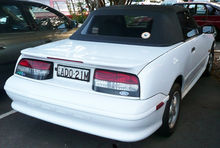
1993–1994 Ford Capri (SE) XR2 convertible.
South Africa
Mk I
Ford of South Africa assembled the Capri from 1970 to 1972 with a similar model range to the UK. No facelift models or RS variants were marketed in South Africa.
About 500 Capris were converted by specialist Basil Green Motors to run the 302 Ford Windsor V8 engine. These models were known as the Capri Perana and were very successful in local touring car events, winning the 1970 South African championship and, in a different format, the 1971 championship as well.
No Mk II and Mk III Capris were exported to, or built in South Africa.
Motorsport
Zakspeed Ford Capri
Zakspeed Ford Capri
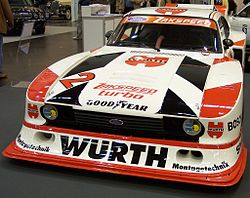 |
| Category | Group 5 (racing) |
|---|
| Constructor | Zakspeed |
|---|
| Technical specifications |
|---|
| Chassis | Alloy tube structure with alloy sheet floorplan, bonded to kevlar bodypanels |
|---|
| Suspension (front) | Alloy wishbones, titanium concentric coil spring, gas dampers |
|---|
| Suspension (rear) | Alloy rear axle, radius locating arms, Watts linkage, titanium concentric coil spring, gas dampers |
|---|
| Engine | Based on Cosworth BDA 1.4-litre I-4 twin-turbo, FR |
|---|
| Transmission | Getrag 5-speed ZF LSD with 90 percent locking efficiency |
|---|
| Tyres | Goodyear 10.0/225 × 16 (front);
12.5/225 × 19 (rear) |
|---|
| Competition history |
|---|
| Notable entrants | Ford Motorsport |
|---|
| Notable drivers | Klaus Ludwig, Jochen Mass |
|---|
| Races | Wins | Poles | Fastest laps |
|---|
| 14 | 9 | 12 | |
|

Jochen Mass's 1980 Group 5 Zakspeed Ford Capri racer
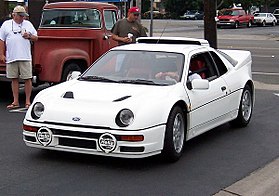


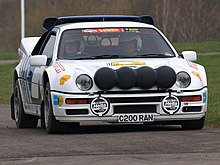
























![Validate my RSS feed [Valid RSS]](valid-rss-rogers.png)














































































